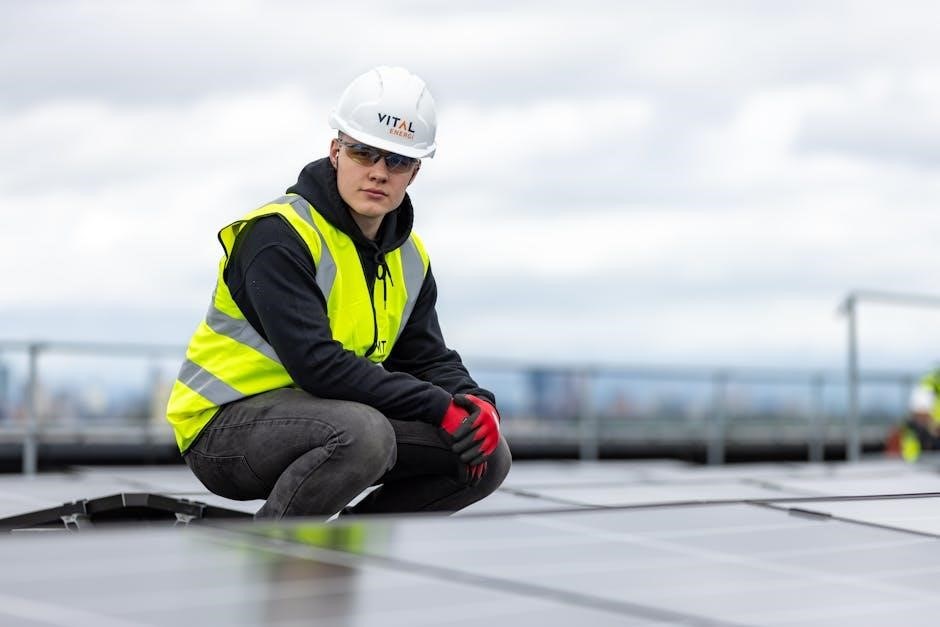The EG4 18KPV hybrid solar inverter is a cutting-edge solution for renewable energy systems‚ designed to optimize solar power utilization and energy storage․ This manual provides detailed installation guidelines‚ safety protocols‚ and operational procedures to ensure efficient and safe system setup․ By following the instructions‚ users can maximize the inverter’s performance and integrate it seamlessly with solar panels and battery banks‚ achieving a reliable and sustainable energy solution․
1․1 Overview of the EG4 18KPV Hybrid Solar Inverter
The EG4 18KPV hybrid solar inverter is a high-performance‚ versatile energy management solution designed for solar power systems․ It combines the functions of a solar inverter‚ battery charger‚ and energy manager in one compact unit․ This inverter is ideal for both off-grid and grid-tied applications‚ offering efficient energy conversion and storage capabilities․ With a maximum power capacity of 18kW‚ it supports large-scale solar installations and battery integration․ The system is designed to optimize energy harvest‚ reduce energy losses‚ and provide reliable backup power during outages․ Its advanced monitoring and control features ensure optimal performance and seamless integration with solar panels and battery banks․ Proper installation and configuration are essential to unlock its full potential․
1․2 Key Features and Benefits of the EG4 18KPV
The EG4 18KPV hybrid solar inverter offers several key features that make it a standout choice for solar energy systems․ Its high efficiency ensures maximum energy conversion‚ while the built-in battery management system optimizes charge and discharge cycles․ The inverter supports multiple operational modes‚ including grid-tied‚ off-grid‚ and backup power modes‚ providing flexibility for various applications․ It also features advanced monitoring capabilities‚ allowing users to track system performance in real-time․ The compact design and ease of installation make it suitable for both residential and commercial setups․ Additionally‚ the EG4 18KPV is compatible with a wide range of solar panels and battery banks‚ ensuring scalability and adaptability to different energy needs․ These features collectively enhance system reliability and performance‚ making it a robust solution for renewable energy systems․
Pre-Installation Requirements
Ensure site compatibility‚ verify system requirements‚ and gather all necessary tools and materials before starting the installation process to guarantee a smooth and efficient setup․
2․1 System Compatibility and Site Assessment

Before installation‚ ensure the EG4 18KPV inverter is compatible with your solar panels‚ battery bank‚ and existing electrical system․ Conduct a thorough site assessment to evaluate environmental conditions‚ such as sunlight exposure‚ temperature ranges‚ and available space․ Verify that the installation location meets local electrical codes and regulations․ Check the system’s voltage and power requirements to ensure they align with your energy needs․ Proper site assessment and compatibility checks are crucial for optimal performance and safety․ Refer to the user manual for detailed specifications and guidelines to ensure a seamless integration with your renewable energy setup․

2․2 Tools and Materials Needed for Installation
To ensure a smooth installation of the EG4 18KPV hybrid solar inverter‚ gather the necessary tools and materials․ Required items include mounting brackets‚ screws‚ and bolts for securing the inverter․ Additionally‚ obtain appropriate wiring‚ connectors‚ and fuses to connect the solar panels and battery bank․ A multimeter is essential for verifying electrical connections and voltage levels․ Safety gear‚ such as insulated gloves and safety glasses‚ should be on hand․ Ensure all materials meet local electrical standards and regulations․ Refer to the user manual for specific recommendations on tools and materials to guarantee compatibility and compliance with installation guidelines․

Safety Instructions and Precautions
Always follow safety guidelines to prevent accidents․ Disconnect power sources before installation․ Wear protective gear‚ including gloves and safety glasses․ Ensure proper ventilation and avoid overloading circuits․ Adhere to local electrical regulations and manufacturer instructions for safe system setup and operation․

3․1 General Safety Guidelines
Ensure all power sources are disconnected before starting installation․ Wear protective gear‚ including gloves and safety glasses‚ to prevent injury․ Maintain a well-ventilated workspace to avoid inhalation of harmful fumes․ Avoid overloading circuits‚ as this can lead to system damage or fire hazards․ Always follow local electrical codes and manufacturer instructions․ Keep the area clear of flammable materials and ensure proper grounding of the system․ Never attempt installation during adverse weather conditions․ If unsure about any step‚ consult the user manual or seek professional assistance․ Regularly inspect equipment for damage or wear and tear․ Adhere to all safety warnings and precautions outlined in the manual to ensure a safe and successful installation process․
3․2 Electrical Safety Measures
Always disconnect all power sources before performing any electrical work․ Use appropriately rated tools and materials to avoid electrical shock or fire hazards․ Ensure proper grounding of the system to prevent voltage spikes and ensure safe operation․ Follow all local and national wiring standards and regulations․ Never overload circuits‚ as this can lead to system damage or fire risks․ Keep the workspace dry and free from flammable materials․ Avoid working in hazardous environments‚ such as areas with explosive atmospheres․ Use protective equipment‚ including insulated gloves and safety glasses‚ when handling electrical components․ Refer to the user manual for specific electrical safety guidelines and ensure all connections are secure and properly insulated․ Adhere to these measures to ensure a safe and reliable installation process․
3․3 Handling and Storage Precautions
Handle the EG4 18KPV inverter with care to avoid physical damage․ Avoid exposing the unit to extreme temperatures‚ humidity‚ or direct sunlight during storage․ Store the inverter in a dry‚ cool‚ and well-ventilated area‚ away from flammable materials․ Ensure the system is kept upright and secure to prevent tipping․ Avoid stacking heavy objects on top of the inverter․ Before installation‚ inspect the unit for any visible damage or defects․ Use appropriate lifting techniques to prevent strain or injury․ Keep the inverter away from chemicals or corrosive substances․ Follow the user manual for specific storage and handling guidelines to maintain the system’s integrity and ensure optimal performance․ Proper storage and handling are crucial for the longevity and reliability of the EG4 18KPV system․

Installation Steps
Mount the EG4 18KPV inverter securely‚ connect solar panels and battery bank‚ and complete wiring and electrical connections․ Follow all safety standards and installation guidelines carefully․
4․1 Mounting the Inverter
Mount the EG4 18KPV inverter on a sturdy wall‚ ensuring it is level and securely fastened․ Choose a location with good ventilation to prevent overheating․ Use the provided mounting brackets and screws to attach the inverter firmly․ Ensure the surface is clean and dry before installation․ Follow the manufacturer’s guidelines for weight distribution and spacing․ Double-check all connections before powering up․ Refer to the user manual for specific torque and alignment requirements․ Proper mounting ensures optimal performance and longevity of the system․ Always wear safety gear during installation․ If unsure‚ consult a certified technician․ Ensure compliance with local electrical codes and standards․
4․2 Connecting Solar Panels and Battery Bank
Connect the solar panels to the EG4 18KPV inverter using MC4 connectors‚ ensuring polarity is correctly matched․ Verify the solar array’s voltage and current ratings align with the inverter’s specifications․ Secure all connections tightly to prevent loose contacts․ For the battery bank‚ use appropriately sized cables and connect the positive and negative terminals as per the manual․ Ensure the battery bank’s total voltage and capacity are compatible with the inverter․ Double-check all wiring for proper insulation and secureness․ Follow the manufacturer’s guidelines for series or parallel configurations․ Always disconnect the battery before making any adjustments․ Refer to the user manual for specific wiring diagrams and safety precautions․
4․3 Wiring and Electrical Connections
Begin by connecting the solar panels to the EG4 18KPV inverter using MC4 connectors‚ ensuring correct polarity․ Secure all connections firmly to avoid loose contacts․ For the battery bank‚ use appropriately sized cables and connect the positive and negative terminals as specified․ Verify the battery bank’s total voltage and capacity match the inverter’s requirements․ Tighten all terminals to prevent electrical resistance․ Inspect all wiring for proper insulation and secureness․ Refer to the wiring diagram in the user manual for specific configurations․ Always disconnect the power source before making any adjustments․ Ensure all connections comply with local electrical codes and standards․ Double-check the system for any short circuits or miswiring before powering up․

System Configuration
Configure the EG4 18KPV inverter for optimal performance by setting up battery charge parameters‚ network connectivity‚ and monitoring systems․ Ensure all settings align with your energy requirements․
5․1 Setting Up the Inverter for Optimal Performance
To ensure the EG4 18KPV inverter operates at peak efficiency‚ follow the installation manual’s guidelines for configuring system settings․ Begin by setting the charge parameters for your battery bank‚ ensuring they align with your energy storage needs․ Next‚ configure the inverter’s operating modes to match your energy usage patterns‚ such as prioritizing solar power during daylight hours․ Additionally‚ set up the network connectivity to enable remote monitoring and control․ Refer to the user manual for detailed steps on adjusting these settings․ Proper configuration ensures optimal energy harvesting‚ storage‚ and distribution‚ maximizing the system’s overall performance and reliability․
5․2 Configuring Battery Bank and Charge Settings
Configuring the battery bank and charge settings is crucial for optimizing energy storage and system performance․ Begin by defining the battery type‚ capacity‚ and voltage in the inverter’s settings to ensure compatibility․ Set the charge and discharge parameters according to your energy needs‚ ensuring they align with the battery manufacturer’s specifications․ Enable communication between the inverter and battery bank for seamless operation․ Refer to the user manual for specific instructions on configuring these settings․ Proper setup ensures efficient energy storage‚ prolongs battery life‚ and maintains system reliability․ Always follow the manufacturer’s guidelines to avoid potential issues and ensure safe operation․
5․3 Network and Monitoring Setup
Setting up the network and monitoring system allows for real-time tracking of your EG4 18KPV inverter’s performance․ Connect the inverter to your local network using Ethernet or Wi-Fi for remote monitoring․ Access the inverter’s web interface through its IP address to configure monitoring settings․ Enable data logging to track energy production‚ battery status‚ and system efficiency․ Install the EG4 monitoring app on your smartphone or tablet for on-the-go monitoring․ Ensure the inverter is connected to the internet for firmware updates and remote support․ Proper network setup ensures seamless monitoring and optimal system performance․ Refer to the user manual for detailed instructions on configuring network and monitoring settings․

Operational Modes
The EG4 18KPV operates in multiple modes‚ including grid-tie‚ off-grid‚ and hybrid․ Each mode optimizes energy use based on system requirements․ Refer to the manual for mode switching details․
6․1 Understanding Different Operation Modes
The EG4 18KPV hybrid solar inverter offers multiple operational modes to suit various energy needs․ In grid-tie mode‚ it synchronizes with the utility grid‚ allowing excess energy to be sold back․ Off-grid mode enables standalone operation‚ ideal for remote locations without grid access․ The hybrid mode combines both‚ offering a balance between grid reliance and renewable energy use․ Additionally‚ a backup mode ensures continuous power supply during grid outages by utilizing stored battery energy․ Each mode is designed to maximize efficiency and reliability‚ catering to different scenarios and user preferences․ Understanding these modes is crucial for optimizing system performance and energy management․
6․2 Switching Between Modes
Switching between operation modes on the EG4 18KPV inverter is straightforward and can be done via the control panel or remote monitoring software․ Users can manually select the desired mode based on their energy needs․ For instance‚ switching to backup mode during a grid outage ensures uninterrupted power supply from the battery bank․ The system automatically detects the mode change and adjusts its operation accordingly; It is essential to follow the sequence outlined in the user manual to avoid any disruptions․ The inverter’s intelligent design ensures a smooth transition between modes‚ maintaining stability and efficiency․ Always refer to the manual for specific instructions to prevent any operational issues during mode switching․
Monitoring and Maintenance

Regular monitoring and maintenance ensure the EG4 18KPV system operates efficiently․ Use the provided software for real-time performance tracking and perform routine checks as outlined in the manual․
7․1 Setting Up Monitoring Systems
To ensure optimal performance‚ the EG4 18KPV system requires a robust monitoring setup․ Begin by installing the provided monitoring software‚ which enables real-time data tracking of solar input‚ battery levels‚ and energy usage․ Connect the inverter to your local network using Ethernet or Wi-Fi‚ following the instructions in the user manual․ Configure the system to display key metrics such as power generation‚ storage capacity‚ and grid synchronization․ For advanced monitoring‚ integrate with compatible smart devices or energy management platforms; Regularly update the software to access new features and improvements․ This setup allows for remote monitoring‚ ensuring you can track and manage your energy system efficiently from anywhere․
7․2 Routine Maintenance Tasks
Regular maintenance is essential to ensure the EG4 18KPV system operates efficiently and safely․ Begin by inspecting all electrical connections to prevent loose wires‚ which can cause malfunctions․ Clean the inverter’s exterior and internal components to remove dust or debris that may affect performance․ Check the battery bank regularly to ensure proper charge levels and connections․ Update the system software periodically to access the latest features and improvements․ Additionally‚ review the monitoring data to identify potential issues early․ Perform these tasks as outlined in the user manual to maintain system reliability and longevity․ Routine maintenance helps prevent unexpected downtime and ensures optimal energy production and storage․ Always follow safety guidelines during maintenance procedures․

7․3 Troubleshooting Common Issues
Troubleshooting the EG4 18KPV system involves identifying and resolving common issues promptly to ensure uninterrupted operation․ Start by checking all electrical connections for tightness and integrity‚ as loose connections can cause system malfunctions․ Verify that the solar panels and battery bank are properly configured and functioning within specified parameters․ If the inverter displays error codes‚ refer to the user manual for detailed explanations and solutions․ Software updates should also be checked and installed to resolve any firmware-related issues․ Additionally‚ ensure the system is grounded correctly to prevent electrical hazards․ Regularly review the monitoring data to detect potential problems early․ Always follow the troubleshooting steps outlined in the manual to restore optimal performance and safety․ Proper diagnosis and resolution of issues ensure the system operates efficiently and reliably․
The EG4 18KPV system‚ when installed and configured correctly‚ offers reliable and efficient energy management․ Ensure all steps are followed for optimal performance and safety․
8․1 Final Checks and System Verification
After completing the installation‚ perform a thorough system verification to ensure all components function correctly․ Start with a visual inspection of all connections‚ ensuring they are secure and meet safety standards․ Verify that the inverter‚ solar panels‚ and battery bank are properly aligned and configured․ Conduct electrical tests to confirm voltage‚ current‚ and power output match specifications․ Check the monitoring system to ensure real-time data is accurately displayed․ Test all operational modes to confirm smooth transitions and functionality․ Review the user manual for any additional verification steps specific to your setup․ Proper verification ensures optimal performance‚ safety‚ and reliability of the EG4 18KPV system․
8․2 References and Further Reading
For comprehensive understanding and troubleshooting‚ refer to the official EG4 18KPV user manual and technical specifications․ Additional resources include the manufacturer’s website‚ which offers detailed guides‚ FAQs‚ and software updates․ Consult local electrical codes and regulations for compliance․ Supplementary materials‚ such as installation videos and technical bulletins‚ are available on the EG4 Electronics support page․ For advanced configurations‚ review the EG4 18KPV configuration guide․ These resources ensure optimal system performance and address specific installation or operational queries․ Always verify information from trusted sources to maintain system integrity and safety․
